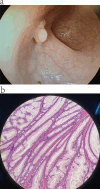Preoperative multimodal ultrasonic imaging in a case of Peutz-Jeghers syndrome complicated by atypical lobular endocervical glandular hyperplasia: a case report and literature review
- PMID: 38419118
- PMCID: PMC10900695
- DOI: 10.1186/s13053-024-00275-7
Preoperative multimodal ultrasonic imaging in a case of Peutz-Jeghers syndrome complicated by atypical lobular endocervical glandular hyperplasia: a case report and literature review
Abstract
Background: Peutz-Jeghers syndrome (PJS), an autosomal dominant multiple cancerous disorder, is clinically characterized by mucocutaneous macules and multiple gastrointestinal hamartomatous polyps. Gastric-type endocervical adenocarcinoma (G-EAC), a special subtype of cervical adenocarcinoma with non-specific symptoms and signs, is known to occur in approximately 11% of female patients with PJS.
Case presentation: Here, we report a case of PJS in a 24-year-old female with multiple mucocutaneous black macules who complained of vaginal discharge and menorrhagia. Moreover, we first described the multimodal ultrasonographical manifestations of PJS-correlated G-EAC. The three-dimensional reconstructed view of G-EAC on 3D realisticVue exhibited a distinctive "cosmos pattern" resembling features on magnetic resonance imaging, and the contrast-enhanced ultrasound displayed a "quick-up and slow-down" pattern of the solid components inside the mixed cervical echoes. We reported the multimodal ultrasonographical characteristics of a case of PJS-related G-EAC, as well as reviewed PJS-related literature and medical imaging features and clinical characteristics of G-EAC to provide insight into the feasibility and potential of utilizing multimodal ultrasonography for the diagnosis of G-EAC.
Conclusions: Multimodal ultrasound can visualize morphological features, solid components inside, and blood supplies of the G-EAC lesion and distinguish the G-EAC lesion from normal adjacent tissues. This facilitates preoperative diagnosis and staging of PJS-related G-EAC, thereby aiding subsequent health and reproductive management for patients with PJS.
We reported multimodal ultrasonographical characteristics of a case of Peutz-Jeghers syndrome-related gastric-type endocervical adenocarcinoma (G-EAC), indicating the potential use of multimodal ultrasonography for G-EAC diagnosis.
Keywords: Atypical lobular endocervical glandular hyperplasia; Contrast-enhanced ultrasonography; Gastric-type endocervical adenocarcinoma; Multimodal ultrasonography; Peutz-Jeghers syndrome; Three-dimensional ultrasonography.
© 2024. The Author(s).
Conflict of interest statement
The authors declare that they have no competing interests.
Figures









Similar articles
-
Novel ultrasound features and diagnostic clues of gastric-type endocervical adenocarcinoma: a case series.Front Oncol. 2025 May 14;15:1572438. doi: 10.3389/fonc.2025.1572438. eCollection 2025. Front Oncol. 2025. PMID: 40438685 Free PMC article.
-
Lobular endocervical glandular hyperplasia diagnosed during surveillance for Peutz-Jeghers Syndrome: A case report.Gynecol Oncol Rep. 2025 Jan 16;57:101673. doi: 10.1016/j.gore.2024.101673. eCollection 2025 Feb. Gynecol Oncol Rep. 2025. PMID: 39895895 Free PMC article.
-
Peutz-Jeghers syndrome with gastric-type mucinous endocervical adenocarcinoma and sex-cord tumor with annular tubules: A case report.Front Med (Lausanne). 2023 Mar 21;10:1094839. doi: 10.3389/fmed.2023.1094839. eCollection 2023. Front Med (Lausanne). 2023. PMID: 37025955 Free PMC article.
-
Gastric-type adenocarcinoma of the cervix in patients with Peutz-Jeghers syndrome: a systematic review of the literature with proposed screening guidelines.Int J Gynecol Cancer. 2022 Jan;32(1):79-88. doi: 10.1136/ijgc-2021-002997. Epub 2021 Dec 13. Int J Gynecol Cancer. 2022. PMID: 34903560
-
Peutz-Jeghers Syndrome and the Role of Imaging: Pathophysiology, Diagnosis, and Associated Cancers.Cancers (Basel). 2021 Oct 13;13(20):5121. doi: 10.3390/cancers13205121. Cancers (Basel). 2021. PMID: 34680270 Free PMC article. Review.
Cited by
-
Novel ultrasound features and diagnostic clues of gastric-type endocervical adenocarcinoma: a case series.Front Oncol. 2025 May 14;15:1572438. doi: 10.3389/fonc.2025.1572438. eCollection 2025. Front Oncol. 2025. PMID: 40438685 Free PMC article.
References
Grants and funding
LinkOut - more resources
Full Text Sources

